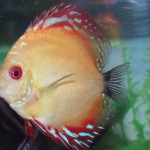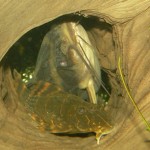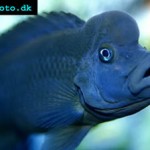When designing a lighting system for any aquarium, we are faced with a multitude of products to choose from. This is due, in part, to the many advancements that have been made in the lighting industry over the past decade. It is important to know the spectrum and intensity of light that is required by the organisms that will be kept in the aquarium prior to designing the lighting system. The various types of lighting systems also differ in price, operating costs, and the amount of heat produced by the bulbs and ballasts. This article will explain the various lighting systems that are offered on the market and their characteristics. A table at the end of the article summarizes this information.
The most common lighting systems available for aquarium use include:
- Incandescent
- Fluorescent
- Standard fluorescent
- HO and VHO fluorescent
- Power compact fluorescent
- Metal halide
- HQI
It is important to remember that the bulbs and ballasts associated with these systems are specific to those systems and cannot be interchanged.
Incandescent
Incandescent bulbs are the typical lights used in the home for general use. An incandescent light consists of a glass bulb with a filament within it. When electricity is passed through the filament, it causes the filament to heat up and glow, producing light. Incandescent lights are very inexpensive, feature long lamp life, and come in a variety of colors. However, their uses in the aquarium hobby are limited due to both the low spectrum of light and the amount of heat produced. Due to these factors, incandescent bulbs are only offered in low wattages, making them useful only on small, fish-only aquariums, which do not require a wide light spectrum or intensity.
Lighting systems requiring ballasts
Other than incandescent, all other aquarium lighting systems require ballasts that have been designed for that specific system. A ballast provides the correct starting voltage and maintains the correct current to the bulb. There are two different types of ballasts available: magnetic and electronic. Electronic ballasts are relatively new to the industry and feature a smaller, cooler running design. Not only do the electronic ballasts produce less heat, they are also more energy efficient and feature a longer bulb life. For example, bulbs used for a planted or reef aquarium with a magnetic ballast system should be replaced after 6 months of operation. However, with an electronic ballast, these same bulbs can be kept in operation for 18 to 24 months without significant losses in spectrum or intensity. Although electronic ballasts are more expensive initially, the energy savings and lower bulb replacement costs are significant over the life of the system.
Types of fluorescent lighting: There are many different types of fluorescent systems available on the market today, making them the most popular type of lighting system. The different types of fluorescent systems include; standard, HO (High Output) and VHO (Very High Output), and power compact. Fluorescent bulbs come in many different sizes, wattages, and spectrum ranges, which make them one of the most versatile systems. All of these systems require a ballast that is specific to that system. The bulbs cannot be interchanged between systems.
A fluorescent light consists of a glass tube filled with gas. Electricity is passed through the tube causing the gasses within the tube to heat to the point to where they glow, producing light. Different spectrums of light are achieved by coating the inside of the tube with different blends of phosphors. As the light passes through the coating, the phosphors produce colors based on their chemical makeup. Over time, however, the gas and coating within the bulb will degrade with use, changing both the intensity and spectrum of the light produced by the bulb. It is important that these bulbs are changed on a regular basis.
Standard fluorescent: A standard fluorescent system includes a ballast that is designed to operate bulbs in the size range from 18″ to 72″ in length. Along with the different lengths, bulbs are also offered in different diameters. The diameter is represented by the bulb’s T rating. The T rating is based on a scale of 1/8 inch. Therefore, a bulb with a T rating of 8 has a 1″ diameter. The most common diameters for standard fluorescent bulbs are a T-8 and T-12. Most fixtures will accept either of the two, but the wattages are different. For two bulbs of the same length, the one smaller in diameter will have a lower wattage. For example, a 48″ T-12 bulb produces 40 watts, whereas a 48″ T-8 bulb only produces 32 watts. Also, fluorescents offer a wide variety of spectrums to choose from. These spectrums range from the fish-only beauty lights, to specialty plant bulbs, all of the way up the Kelvin scale to the actinic bulbs for saltwater aquariums.
The initial cost of standard fluorescents are in the low to medium price range depending on the type of ballast included. The commonly available sizes for these systems range from 18″ to 48″ with wattages from 15 to 40 watts. The operating costs for these systems are low in comparison to other types of lighting. Bulb replacement is recommended on these systems every 6 to 18 months, again depending on the type of ballast that is used. Another advantage to these systems is the lower amount of heat produced. Therefore, an aquarium that is illuminated with standard fluorescents typically does not require a water chiller or a hood with cooling fans. Standard fluorescent systems are a good choice for both freshwater and saltwater fish-only aquariums. Multiple-bulb systems can also be used for aquariums housing only those live plants and corals that require low light levels.
HO and VHO fluorescent: High Output (HO) and Very High Output (VHO) fluorescents are similar in design to the standard fluorescent, but offer higher light output in the same size bulb. They require a different ballast and end caps than are used with the standard fluorescent systems. The bulbs for HO and VHO cannot be used with a standard fluorescent system. With the advent of VHO bulbs, which produce more light per watt, HO bulbs are not commonly used.
These systems fall into the medium price range and will vary depending on whether the system includes a magnetic or electronic ballast. These bulbs are available from 24″ to 72″ long, with various T ratings, and with wattages ranging from 75 to 160 watts. Because of the wattage difference, these systems will use more electricity and are more expensive to operate than the standard fluorescents. Bulbs should be replaced every 4 to 6 months with a magnetic ballast, and every 12 to 24 months with an electronic ballast.The heat generated by the HO and VHO bulbs needs to be addressed prior to the installation. At the very least, ventilation fans should be incorporated into the lighting hood. Otherwise, depending on room temperature, a water chiller should be included in the budget for the installation.
The HO and VHO systems are typically used for saltwater reef aquariums. These systems are also used for taller aquariums (24″ or more) that require the extra wattage to illuminate the bottom of the aquarium. The spectrum available for these systems is typically in the higher Kelvin range, making them unsuitable for freshwater planted aquariums unless supplemental lighting is incorporated to provide the correct spectrum.
Power compact fluorescent: Power compact fluorescent systems operate with the same principles as the other types of fluorescent systems. Their appearance is different when compared to other systems. Instead of using one glass bulb, power compacts incorporate bulbs that have a twin tube design. When looking at the wattage ratings on these bulbs, the rating includes both tubes in the total output of the bulb.
Power compact fluorescent systems fall into the medium price range and are modest on energy consumption. They range from 6″ to 34″ in length with intensities of 9 to 96 watts. There are two commonly available designs: square pin and straight pin socket bases. These bulbs require the sockets that have been designed for the pin layout of the specific bulb type and cannot be interchanged. Because they are operated by an electronic ballast, the average life of these bulbs is 14 to 24 months, depending on the number of hours per day that they are used.
Like the other high-powered fluorescent systems, the power compacts produce an amount of heat that is proportional with the number of watts of the system. When multiple bulbs are used, a cooling fan should ideally be incorporated into the lighting hood to remove any excess heat. A water chiller may be needed when illuminating an aquarium with approximately 4 watts per gallon or more depending on room temperature.
Power compact fluorescents are an excellent choice for any type of aquarium. They are available in a wide range of spectrums, ranging from the low Kelvin rated bulbs for freshwater planted aquariums up to the blue spectrum needed for saltwater reef aquariums. Because of the low operating cost and the longevity of the bulbs, these systems are a good choice for most aquariums.
Metal halide: Metal halide bulbs are similar to incandescent bulbs in appearance, but offer higher intensities and wattages. Metal halides also offer spectrum ranges that have been designed for the aquarium industry. A metal halide light consists of a glass bulb with a series of wires connected to another glass bulb within it. When electricity passes through this interior glass bulb, it causes the gas to produce light. The base of the bulb is threaded like an incandescent lamp, but requires a special socket, called a mogul, that is specific to that system. The ballast required to operate this system is typically located in the cabinet below the aquarium, where the heat it produces will not be added to the aquarium.
There is a wide range of bulbs available for the metal halide systems with spectrums ranging from 4000K up to 20,000K, and intensities ranging from 175 watts up to 1000 watts. The metal halide bulbs are expensive; the higher the wattage of the system, the more expensive the bulbs. Bulb prices range from $60 to $120 each for a 175-watt system. Along with the increase in price for bulbs, the higher wattage systems require an increased amount of electricity needed to operate the system.
Metal halide lighting systems are in the high price range for both initial and operating costs. Initial cost will vary depending on the type of ballast and bulb that is included with the system. Magnetic and electronic ballasts are available for these systems.
The higher cost of operating a metal halide system is a result of power usage and bulb replacement costs. Magnetic ballasts for a 175-watt system draw 1.8 amps of power, and electronic ballasts draw 1.47 amps. The electrical cost of operating a metal halide system with a magnetic ballast for 10 hours per day, at an average of $.08 per Kilowatt, is approximately $4.75 per month. The same system with an electronic ballast operating for the same amount of time will cost approximately $3.88 per month. The average life of a metal halide bulb is between 6 and 18 months depending on the type of ballast and the number of hours that the bulb is used per day.
Even though metal halide systems are expensive, they are actually very efficient. Watt for watt, they produce more light than other systems. But because they are used to produce so much light, they do have high energy costs. Trying to produce that much light using other systems would require far too many bulbs or, in reality, be impossible.
The bulbs of a metal halide system produce a large amount of heat that will both warm the air within the lighting hood as well as warm the aquarium water through its radiant heat. Circulation fans are a must with these systems in order to remove the hot air from the lighting hood. Also, a water chiller is typically needed, unless the aquarium water is purposefully being maintained at a high temperature. Raising the lighting system off of the top of the aquarium by at least 8″ can reduce the amount of heat that is transferred to the water. This will allow greater air circulation and will reduce the amount of radiant heat added to the water.
In addition to heat, there are other drawbacks associated with metal halide systems. When in operation, these bulbs become very hot to the touch. The bulb could potentially explode if it is splashed with water while in operation. Furthermore, these bulbs emit some harmful ultraviolet (UV) radiation. Either glass tops should be used to cover the aquarium, or the lighting system needs to be covered by glass. The glass will eliminate both the chance of the bulb being splashed and will reduce the amount of UV rays that enter the water.
Metal halides are different than the other lighting sources mentioned thus far. They are an intense light source coming from a small area that produces an effect that is referred to as glitter lines. Glitter lines are light waves that have been intensified by the movement of the surface of the water. If looking at a pool of water in the sunshine, you will notice light waves dancing on the bottom of the pool as the surface water of the pool moves. These intensified light rays not only produce an attractive effect on the aquarium, but have also been speculated to provide benefits for photosynthesis within corals.
A metal halide system is useful for any aquarium setup that demands high light intensities. It is useful for very tall, fish-only aquariums where the light intensity is needed to illuminate the entire aquarium. This type of lighting is also ideal for freshwater planted and saltwater reef aquariums.
HQI: HQI systems are relatively new to the hobby and offer many of the same features as the metal halides, but differ in design. The bulb is much smaller than the halides and is double ended. Many of the ballasts for the metal halides can also be used for HQIs. The HQI bulbs, however, require a system-specific socket. There is less of a variety of spectrums and wattages to choose from compared to the metal halides. HQIs are commonly offered in 150 watt and 250-watt systems with spectrums of 10,000K and 20,000K. Because of this, these systems are used mostly on saltwater reef aquariums.
Conclusion
Along with the many advancements that have been made in the lighting industry over the past decade, there has been a dramatic increase in our knowledge and understanding of the requirements of photosynthetic organisms. These two key factors have given us the ability to not only sustain many of these organisms in an aquarium setting, but also to raise and propagate them in an environment that is becoming closer to the conditions that occur in nature. When choosing a lighting system, it is important to design that system around the requirements of the organisms that are to be maintained.
















